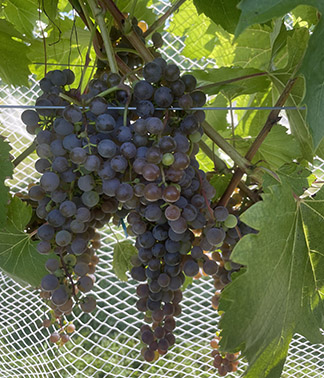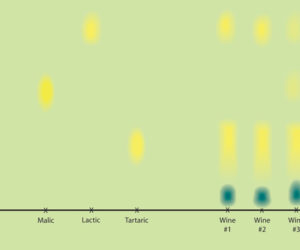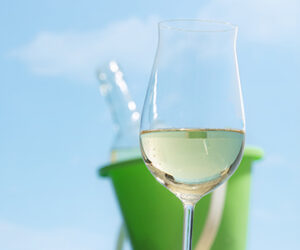Frontenac Gris is a hardy hybrid grape with incredibly complex aromas and flavors, and diverse winemaking potential. In 1992, Peter Hemstad discovered a genetic mutation amongst his plot of Frontenac vines at the University of Minnesota. Instead of the typical deep blue-black skin indicative of Frontenac, the skins were a much lighter mauve-gray hue. After isolating the original mutated bud, it was propagated and cuttings were rooted to create the new cultivar, deemed Frontenac Gris. Frontenac Gris was released for sale in 2003 with vineyard plantings spanning over the northern continental U.S., Midwest, and New England.
In the Vineyard

Frontenac Gris is a very cold-tolerant variety, often having buds withstand temperatures as low as -35 °F (-37 °C). The older and better established the vine is, the better its ability to withstand these sub-zero temperatures. Care should be given to vines less than two years of age to protect them against temperatures below 0 °F (-18 °C). Like most grapes, Frontenac Gris will suffer in wet soils with poor drainage. It has very vigorous growth patterns, with canes running over 20 feet (6 m) if left unpruned. While the vine can be trained in a variety of trellising systems, such as vertical shoot positioning, Geneva double curtain, or high wire trellising, I prefer the high wire trellising system as it accommodates for the vigorous cane growth and best supports the heavy weight of the canopy and clusters. Due to the rapid vegetative growth, vines are often planted 8 feet (2.5 m) apart rather than the traditional 6-foot (2-m) spacing. Even in wet and extreme cold conditions, bud death is very rare.
When training Frontenac Gris, either spur or cane pruning may be utilized. In my experience, pruning back cordons to either 2–3 spurs per foot (0.3 m) with only two buds per spur, or laying down shorter canes with no more than four buds is preferred. As the canes can become very long throughout the growing season, regular pruning is desired to keep the vegetation at bay. Some leaf pulling may be necessary, especially in the instance of foliar phylloxera pressure, and to increase air flow throughout the canopy. This will help to reduce instances of mildew and allow more sun for ripening.
Frontenac Gris exhibits relatively low disease pressure overall. It is moderately susceptible to powdery mildew and foliar phylloxera. In my experience of growing it on multiple farms, foliar phylloxera will more readily appear in Marquette and Frontenac before the Frontenac Gris. It has very low rates of Botrytis and other bunch rots due to the long, gangly nature of the clusters. This loose berry format of the clusters helps with air circulation and even ripening. The clusters average 4.5 oz. (130 g) and 8–10 inches (20–25 cm) in length. The deep mauve color of the grapes will develop after veraison and throughout its ripening season. This color can be nurtured if desired in the wine, but often drops out through the fermentation and maturation process.
Techniques in the Winery
Choice of processing techniques will have great impact on the resulting wine style of Frontenac Gris. Due to the dark pink to warm gray color of the berries upon ripening, the skins can have a tremendous impact on the color, flavor, and phenolic content of the pressed juice. Some vintners opt for whole cluster pressing this variety to minimize skin contact, resulting in a lighter yellow juice. I’ve observed these resulting wines to be lighter bodied, light yellow to toasted straw in color, and have tasting notes of ripe peach and pear with hints of florals and honey.
If the grapes are mechanically destemmed and crushed, even minimal contact time with the skins while sitting in the press will provide a much darker pink juice, appearing at first like a rosé. Anthocyanins will fall out in precipitate throughout the fermentation process, and the juice will lighten from a salmon pink hue to a more rich golden tone. Wines that have more skin contact throughout the crushing and pressing process have more tropical aromas of mandarin orange, mango, honeydew melon, and amber honey.
Frontenac Gris has an incredible amount of aromatic potential and cold fermenting is essential in preserving its aromatic complexity. Fermenting Frontenac Gris around 60 °F (16 °C) will preserve tremendous aroma, whereas fermenting at ambient temperatures of 70–75 °F (21–24 °C) will still produce a wine with nice aroma, but not nearly as powerful nor complex.
Once the crop has been harvested and processed into juice, measurements of its pH, titratable acidity (TA), and Brix level should be taken. Based on these criteria, a selection of yeast may be made. Frontenac Gris has excellent ability to ripen, often having sugar levels rise by 1.5 °Brix per week with optimal ripening conditions. Frontenac Gris does tend to retain acid well throughout its ripening process. It is not uncommon for harvested Frontenac Gris to have a Brix level of 24 and a TA of 14 g/L or higher. Potassium bicarbonate is very often an essential ingredient in the winemaking process of Frontenac Gris to lower the TA to a more reasonable threshold to begin fermentation.
When fermenting Frontenac Gris, there are quite a few yeast strains that will help express the complex character of the grape. Once the pre-fermentation assessments have been completed, these new pieces of information may help dictate a yeast selection. If the winemaker desires to lower some of the acidity further, Lalvin 71B is an excellent choice as it partially consumes malic acid throughout its metabolic process. Vin13 will help to promote the floral, honey, and pineapple aromatics of Frontenac Gris, while Lalvin QA23 will promote more of the peach, melon, and orange aromas. Lalvin R2 is also an excellent yeast strain choice due to its superior cold-tolerance and emphasis on stone fruit and floral aromatics through its enzymatic effect on the aroma precursor compounds. Efforts should be made throughout the fermentation process to keep the wine as cool as possible, depending on the yeast strain’s temperature threshold.
Wine Styles
Due to its naturally high acidity, Frontenac Gris lends itself to a wide variety of finished wine styles. The high acidity gives it excellent potential for sparkling wines with a refreshing quality and a lively, crisp finish. An excellent example of a sparkling Frontenac Gris can be found at Taylor Brooke Winery in Woodstock, Connecticut. Winemaker Nikki Auger limits the skin contact period by going directly from crusher to press to ensure a lighter color and body to the wine, conducive to the sparkling end product. Her brilliant, light straw in hue, sparkling Frontenac Gris has notes of pineapple, lychee, and white grape.
The acid can also support a good amount of back sweetening to create a balanced, sweeter-styled wine. I have had Frontenac Gris in a very wide variety of styles, including sparkling, dry, sweet, and dessert wine. Each manifestation showcases a different aspect of the grape, showing its versatility and strong flavor profile.
At my commercial winery (Hawk Ridge Winery in Watertown, Connecticut), Frontenac Gris contributes two wines to the portfolio. The first is a sweet-styled white wine that has a unique copper hue due to the skin contact time within the press. While the skins are in contact with the juice for only 90–120 minutes, some anthocyanins are extracted by the acidic juice and retained. I find that some limited skin contact helps boost the aromatics of the wine later in its aging. The color compounds do diminish throughout fermentation and after racking. The sweeter-styled Frontenac Gris table white in our portfolio has perfumed aromatics of mandarin orange, honeydew melon, and cooked peaches. When working on the wine, the entire winery is filled with its delicious aromas.
I also use Frontenac Gris as the base wine for a white Port-styled dessert wine. This is a unique wine, with tropical flavors mingling beautifully with a specialty oak treatment and fortified with premium French Brandy. Sweet tropical fruits are complemented by crème brûlée and caramelized honey notes brought on by the oak. The end result is a dynamic dessert wine that is rich in flavor, color, and body, without a cloyingly sweet finish due to the natural acid content.
With the rise in sales of Muscat-based wines and fruit wines alike, parallels could be drawn to Frontenac Gris as it maintains a similar flavor profile. Its extreme cold-tolerance and excellent resistance to disease makes it an easier variety to cultivate and maintain, with crop yields that are consistently around 4 tons per acre. With incredibly powerful aromas of rich tropical fruit and versatility in the winemaking portfolio, this varietal is ripe with opportunity for home and commercial success.
Frontenac Gris Recipe
(5 gallons/19 L)
Ingredients
125 lbs. (57 kg) Frontenac Gris grapes or 6 gallons (23 L) of Frontenac Gris juice
Sanitizing solution of potassium metabisulfite (KMBS)
KMBS powder and citric acid powder
5 g yeast (EC-1118, 71B, QA23, R2, or Vin13)
7.5 g Go-Ferm Sterol Flash
7.5 g of Fermaid O
5 g Fermaid K
5 g Opti-White (optional)
5 g Booster Blanc (optional)
5 g bentonite
Potassium bicarbonate
Distilled water
Table sugar (if Brix is low)
Potassium sorbate
Equipment
Crusher/destemmer
Wine press (if using fresh grapes)
15-gallon (57-L) fermentation bucket or bin
(2) 5-gallon (19-L) carboys
Airlock and bung
Auto-siphon and tubing
pH meter
Hydrometer
Spoon and small mixing bowl
Thermometer
Bulk KMBS sanitizing solution made and stored in water jugs or jars
Glass marbles (optional)
Step by step
1. Ensure all of your equipment is clean and in proper working order. Make a fresh batch of KMBS sanitizing solution using 1 Tbsp. of KMBS powder and 1 Tbsp. of citric acid mixed into 1 gallon (3.8 L) of clean water. Fill a spray bottle with solution and spray your processing equipment, but ensure there is no pooling of sanitizer in bins or press basins.
2. If using fresh grapes, crush and destem, and then press grapes. It is rather critical to press directly after crushing to minimize skin contact time.
3. Transfer juice into sanitized fermentation bucket. Add 50 ppm of KMBS to kill natural yeast. Utilize the sulfite calculator at www.winemakermag.com/sulfitecalculator to assist in your calculations. If using purchased juice, ask the supplier if this has already been done for you, as to avoid overdosing.
4. Take measurements of your juice, including volume, Brix, pH, and titratable acidity (TA). Adjust the juice to have a starting Brix of at least 22, pH of ~3.3, and TA of 8–9 g/L. Frontenac Gris often has a very high TA, so use the pH as the guide to acidity adjustments via the potassium bicarbonate. www.wineadds.com has calculators to assist you with Brix and acidity adjustments.
5. To prepare the yeast, warm up 50 mL of distilled water to 60 °F (16 °C) and add to a mixing bowl. Then add the Go-Ferm Sterol Flash and stir well. Add 5 grams of yeast and stir well. Allow to sit for 15 minutes. Then mix in thoroughly into the juice.
6. Place a lid on the fermentation pail loosely and wait 24 hours to observe yeast activity. Take Brix measurements twice daily via a hydrometer to ensure the start of fermentation. Using the thermometer, take temperature measurements daily. Try to keep the fermentation temperatures as close to 60 °F (16 °C) as possible to preserve the aromatic compounds. To do this, you may need to put the fermentation bin in a cool area of your basement, outdoor porch, refrigerator, or in a larger bin (garbage pail) filled with ice water.
7. After a day or two of fermentation, when the Brix has dropped one or two degrees, it will be time to add some nutrients. Add 100 mL of distilled water to a mixing bowl and add 7.5 grams of Fermaid O, as well as the Opti-White and Booster Blanc if you choose to use them. Adding either of these products adds additional glutathiones that will help preserve delicate aromatics against oxidation. Mix well to create a slurry and then stir into the fermenting juice with a sanitized stir paddle.
8. Continue to monitor Brix and temperatures daily (twice daily would be preferred). When the Brix has declined to between 15–11 °Brix, add the Fermaid K in the same way you added the Fermaid O.
9. Continue to ferment as close to 60 °F (16 °C) as possible until the wine has fermented to dryness (about -1 to -2 °Brix). This should take between 7–21 days.
10. Rack off the gross lees into a sanitized carboy. Add 50 ppm of KMBS and stir well. Affix the bung and airlock and allow to sit for 5–7 days.
11. Rack off the lees into another clean, sanitized carboy. Affix bung and airlock and allow to sit for a month. If you have an air gap after racking, either top off with a complementary wine such as Riesling or Muscat, or add sanitized glass marbles to displace the headspace.
12. Rack again into a sanitized carboy and add another 50 ppm of KMBS. At this point, the wine should give off minimal lees and should be hazy but not opaque. Consider fining with bentonite to clarify and help with heat stabilization. Mix bentonite according to its directions. Add to wine and allow to settle over 2–3 weeks. Once bentonite has settled, rack the wine off the lees using the auto-siphon into a clean and sanitized carboy.
13. Allow the wine to sit and age, maintaining a free SO2 level appropriate for the pH. The sulfite calculator will help you determine the proper dosage given the parameters of pH and volume. You may consider cold stabilizing or acquiring a cold stabilizing product such as Zenith or CelStab. These products may only be used if the wine is filtered down to 0.5 micron as turbidity will interfere with their effectiveness. If filtration is not available, try to cold stabilize via exposure to cold (put wine in a plastic container, do not try to cold stabilize in a glass carboy).
14. Once cold stability has been achieved via physical or chemical means, taste the wine and see if you desire some sweetness to balance. If you would like to backsweeten, raise the free SO2 to 50 ppm, and add 1 g/gallon (3.8 L) of potassium sorbate. Stir well, then add whatever amount of sweetener you would like to achieve the desired end result.
15. Bottle wine once you are content with the flavor and stability of the wine. Always add a small amount of sulfite before bottling (10 ppm beyond the sulfite calculator’s recommended value to account for oxygen uptake during the bottling process).







